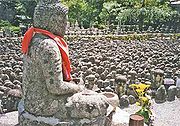
Adashino Nembutsu-ji
Encyclopedia


Temple
A temple is a structure reserved for religious or spiritual activities, such as prayer and sacrifice, or analogous rites. A templum constituted a sacred precinct as defined by a priest, or augur. It has the same root as the word "template," a plan in preparation of the building that was marked out...
in Ukyo-ku
Ukyo-ku, Kyoto
is one of the eleven wards in the city of Kyoto, in Kyoto Prefecture, Japan. The word , as opposed to , refers to the western half of the ancient capital of Heiankyō – the palace faced south, hence west was to the right...
, Kyoto
Kyoto
is a city in the central part of the island of Honshū, Japan. It has a population close to 1.5 million. Formerly the imperial capital of Japan, it is now the capital of Kyoto Prefecture, as well as a major part of the Osaka-Kobe-Kyoto metropolitan area.-History:...
, Japan
Japan
Japan is an island nation in East Asia. Located in the Pacific Ocean, it lies to the east of the Sea of Japan, China, North Korea, South Korea and Russia, stretching from the Sea of Okhotsk in the north to the East China Sea and Taiwan in the south...
. In 811 Kūkai
Kukai
Kūkai , also known posthumously as , 774–835, was a Japanese monk, civil servant, scholar, poet, and artist, founder of the Shingon or "True Word" school of Buddhism. Shingon followers usually refer to him by the honorific titles of and ....
is said to have founded a temple, then Honen
Honen Shonin
is the religious reformer and founder of the first independent branch of Japanese Pure Land Buddhism called . In the related Jōdo Shinshū sect, he is considered the Seventh Patriarch. Hōnen became a monk of the Tendai sect at an early age, but grew disaffected, and sought an approach to Buddhism...
altered it to the present Nenbutsuji. Situated high on a hill overlooking the city from the northwest, it sits in an area where since the Heian period
Heian period
The is the last division of classical Japanese history, running from 794 to 1185. The period is named after the capital city of Heian-kyō, or modern Kyōto. It is the period in Japanese history when Buddhism, Taoism and other Chinese influences were at their height...
people have abandoned the bodies of the dead, exposing them to the wind and rain. Now, some eight thousand Buddhist statuettes, which had been scattered around Adashino then collected about 1903, memorialize the souls of the dead. During its well-known 'sento kuyo', a ceremony dedicated to the spirits of the dead, about ten thousand stone statues are lit up with candles.
Access
- 17, Adashino-chō, Saga-Toriimoto, Ukyō-ku, Kyoto
- Kyoto Bus (not Kyoto City
Bus
Kyoto Municipal Transportation Bureau
is an agency of the city government of Kyoto, Japan that operates municipal subways and city buses within the city. Previously, it also operated trams and trolley buses.-Subway:The Kyoto Municipal Subway operates the following two lines:*Karasuma Line...
) Toriimoto Stop: 5 minutes walk
See also
- For an explanation of terms concerning Japanese Buddhism, Japanese Buddhist art, and Japanese Buddhist temple architecture, see the Glossary of Japanese BuddhismGlossary of Japanese BuddhismThis is the glossary of Japanese Buddhism, including major terms the casual reader might find useful in understanding articles on the subject. Words followed by an asterisk are illustrated by an image in one of the photo galleries...
.
External links
35.026806°N 135.664522°W

